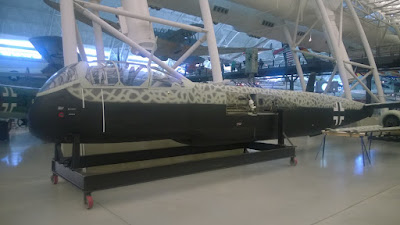One of the chief innovations of the the German night fighters was the Schräge Musik (translated to "Jazz Music") weapon mounting, where one or two 20mm or 30mm cannon were mounted at around a 70° upwards angle in the mid-fuselage. This allowed the aircraft to fly underneath enemy bombers and attack with less risk.
 |
| Messerschmitt Bf. 110G night fighter |
A number of other aircraft were deployed as night fighters, however most of them were either not sufficient improvements over the Ju-88s and Bf-110s, or not produced in sufficient numbers to make a difference. One of the most interesting one, however, was the Heinkel He 219. First operational in June 1943, it was the only German night fighter capable of matching the Mosquito.
Looking somewhat gangly on its tricycle gear, the Uhu (Owl) generally carried an armament of six 20mm cannons facing forwards, and a pair of 30mm cannons in the Schräge Musik position.
 |
| NASM's He 219 in July 2015. |
 |
| Engines and wing panels. Hopefully it'll be fully assembled next time I visit. |


When I saw that He-219 fuselage sitting there, I about lost it. That is WWII warbird nerd crack, right there.
ReplyDeleteNot sure if that, the Do-335, Ho-229, or the Ar-224 that really got me. Actually, never mind, the fact that all those aircraft are in one place is what makes the Udvar-Hazy center such warbird nerd crack.
ReplyDelete